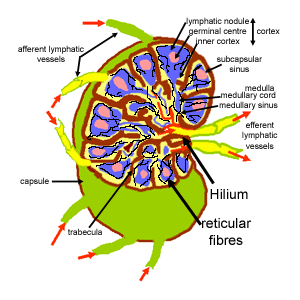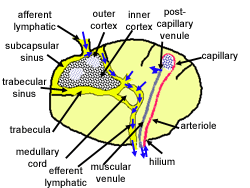What are lymph nodes?
These are about 100-200 100 bean shaped organs, which are found along lymphatic vessels, and which filter micro-organisms etc from lymph.

This is a diagram of a lymph node, cut away to show the organisation inside, into cortical and medullary regions.
Primary follicles: lymphoid follicles without a germinal centre.
Secondary follicles: lymphoid follicles with a germinal centre. These mostly contain B-cells.
The nodes are covered by a capsule of dense connective
tissue, and have capsular extensions, of connective tissue, called
the trabeculae, which provide support for blood
vessels entering into the nodes.
Lymph, containing micro-organisms, soluble antigens,
antigen presenting cells, and a few B-cells, enters the lymph node
via afferent lymphatic vessels which enter the
subcapsular sinus. It then runs through cortical
sinuses into medullary sinuses and leaves
through the efferent lymphatic vessels, at the
Hilium as efferent lymph. This
contains lots of T-lymphocytes, B-lymphocytes, plasma cells and
antibody.
All the blood sinuses are lined by a discontinuous
layer of simple squamous endothelium, and they also contain lymphocytes
and macrophages. Reticular fibres provide additional support to
the matrix/stroma.
The cortex is divided into an outer
and an inner cortex.
The outer cortex has lymphatic nodules that mostly
contain B-cells. Small lymphocytes sit in the spaces between the
reticular fibre meshwork in the cortex. (see the picture below).
The lighter staining areas are germinal centres,
where the B-cells proliferate into antibody secreting
plasma cells (see B-and T-lymphocytes).
Macrophages are also present in these regions,
together with dendritic cells, and some T-cells.
Both the macrophages, and the dendritic cells trap antigens and
present them on their surfaces to B-cells.
The inner cortex contains mostly T-cells.
The deep cortical, and medullary cords contain B-cells and plasma cells.Plasma cells live for 3 days, and make IgG type antibodies.
